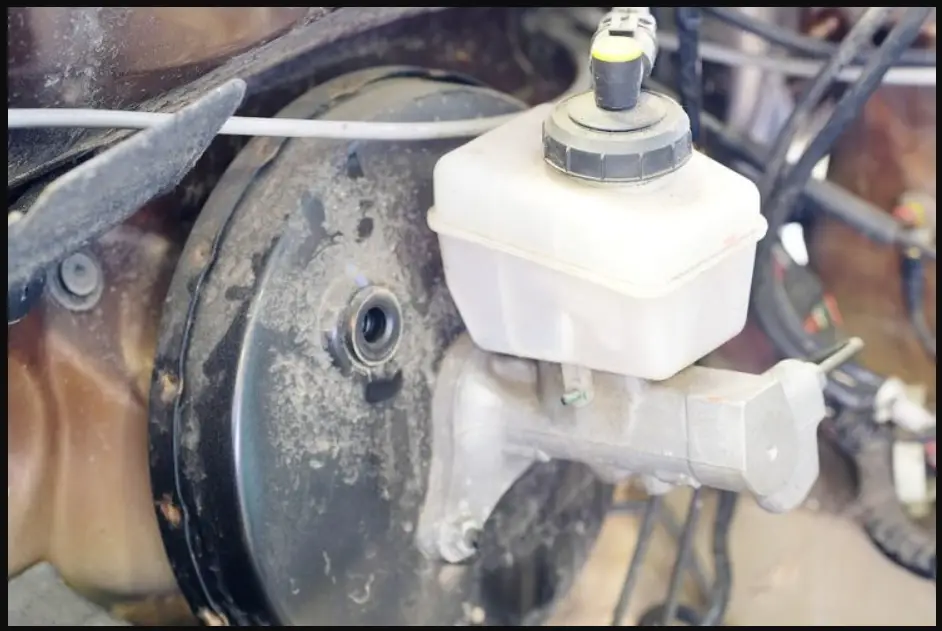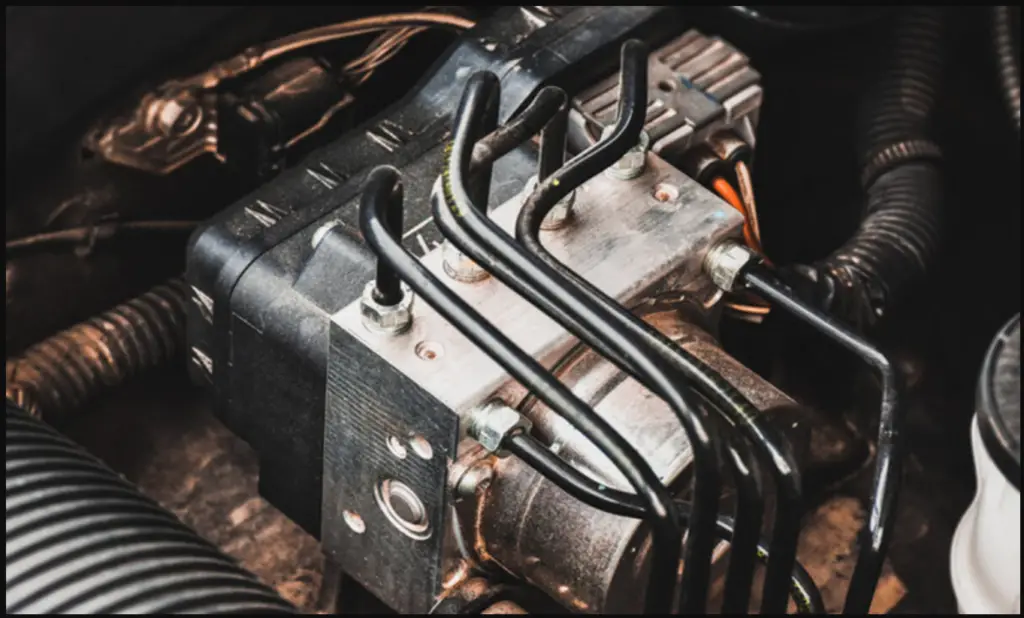Hello fellow riders, and welcome to EngineRides, when experiencing brake problems, determining whether it’s a bad master cylinder or ABS module is crucial for safe driving. Both issues can cause similar symptoms like soft pedals or warning lights. This article simplifies the diagnosis process, highlighting key symptoms and troubleshooting techniques.
By understanding common indicators and basic checks, you can better assess the problem. Whether it’s a spongy pedal or premature wheel lock-ups, knowing how to differentiate and address these issues ensures safer travels on the road.
Table of Contents
What are Bad Master Cylinder Symptoms?
A malfunctioning master cylinder can lead to several distinct symptoms, each indicating potential issues within the braking system. Understanding these symptoms is crucial for diagnosing brake problems accurately and ensuring safe driving conditions.

1. Soft or Spongy Brake Pedal
A soft or spongy brake pedal is one of the primary indicators of a bad master cylinder. When you depress the brake pedal, it feels mushy and lacks the firmness expected in a healthy braking system. This sensation occurs due to air or fluid leaks within the master cylinder or brake lines, leading to reduced hydraulic pressure and compromised brake performance.
Drivers should never ignore a soft or spongy brake pedal, as it indicates potential issues with the braking system that require immediate attention. Ignoring this symptom could lead to brake failure and serious accidents on the road.
Replacing worn-out or damaged components and bleeding the brake system may be necessary to restore proper brake pedal feel and ensure safe driving conditions.
2. Pedal Sinks Slowly to the Floor When Held Down:
Another telltale sign of a bad master cylinder is a brake pedal that sinks slowly to the floor when pressure is applied and held. This phenomenon occurs due to internal leaks within the master cylinder, allowing brake fluid to bypass the seals and escape, resulting in a loss of hydraulic pressure.
When the brake pedal sinks gradually, it indicates that the master cylinder is unable to maintain consistent pressure within the braking system. As a result, drivers may experience difficulty in achieving effective braking force, especially during prolonged or repeated braking maneuvers.
Replacing the master cylinder and performing a thorough brake system inspection can help restore the proper pedal feel and ensure reliable braking performance.
In conclusion, a brake pedal that sinks slowly to the floor is a clear indication of internal issues within the master cylinder.
3. Brake Fluid Leak (External or Internal):
A brake fluid leak is a serious symptom of a bad master cylinder that requires immediate attention. Leaks can occur externally, visible under the vehicle, or internally, within the master cylinder itself. External leaks may appear as wet spots or puddles near the wheels or along the brake lines.
Leaking brake fluid poses significant safety risks, as it can lead to brake failure and loss of vehicle control. Drivers may experience difficulty stopping the vehicle, especially during emergency braking situations.
Drivers should never ignore signs of leaking brake fluid, as they pose significant safety risks and can lead to brake failure if left unaddressed.
Smart Brake System Malfunction Mazda CX-5/CX-9; Causes And Fixing Explained
ENGINERIDES.COM
4. Brake Warning Light May Come On
The brake warning light serves as a crucial indicator of potential issues within the braking system, including problems with the master cylinder. When the brake warning light illuminates on the dashboard, it signifies a malfunction or abnormality that requires attention.
In conclusion, a lit brake warning light is a critical symptom of potential issues with the master cylinder or braking system. Drivers should respond promptly to this warning, as it indicates safety hazards that require immediate attention. Timely diagnosis and repair are essential to ensure the continued safe operation of the vehicle and prevent accidents on the road.
What are Bad ABS Module Symptoms?
Now we know what are the symptoms of a bad master cylinder, and it is time to take a look at the symptoms of a bad ABS module.

1. ABS Warning Light on the Dashboard
The ABS warning light illuminates the dashboard to indicate a malfunction in the ABS. It could result from issues such as faulty sensors, damaged wiring, or a malfunctioning ABS module itself, signaling the need for diagnostic testing and potential repairs to restore ABS functionality.
2. Wheels Locking Up Prematurely During Hard Braking
Premature wheel lock-up occurs when the ABS fails to modulate brake pressure effectively during hard braking.
Instead of maintaining traction and preventing skidding, the wheels lock up prematurely, compromising vehicle control and increasing stopping distances. This symptom highlights potential ABS module or sensor malfunctions requiring immediate attention.
3. Pulsating Brake Pedal (in Normal, Non-ABS Braking Situations)
A pulsating brake pedal sensation, typically experienced during normal braking situations, can indicate ABS module issues.
The ABS may engage unintentionally, causing the brake pedal to pulsate as it modulates brake pressure inconsistently. This symptom warrants thorough inspection and diagnosis to identify underlying ABS module malfunctions.
4. Potentially, Unusual Noises from the ABS Unit
Unusual noises emanating from the ABS unit, such as grinding, buzzing, or clicking sounds, could signal malfunctioning components within the ABS module.
These noises may indicate mechanical or electrical issues, including damaged solenoids or defective sensors, necessitating immediate inspection and potential repairs to ensure ABS functionality and vehicle safety.
What are the overlapping symptoms of both?
Overlapping symptoms, such as a lit warning light, can be challenging to differentiate between a bad master cylinder and a faulty ABS module. Both scenarios can trigger the warning light, complicating diagnosis.
Furthermore, a failing ABS module can indirectly impact brake pedal feel by mismanaging hydraulic pressure. In such cases, the ABS’s improper modulation of pressure can lead to a spongy or unpredictable brake pedal sensation, blurring the line between the ABS module and master cylinder issues.
Thus, careful inspection and diagnostic testing are essential to accurately identify the root cause of brake system abnormalities and ensure appropriate repairs are undertaken for optimal safety.
How to troubleshoot the problems with ease?
When troubleshooting brake problems, a systematic approach ensures thorough evaluation and accurate identification of issues. The following steps outline a structured process for diagnosing potential problems with the master cylinder and ABS module:
1. Start with the Basics
- Check Brake Fluid Level and Inspect for Leaks – Begin by examining the brake fluid reservoir to ensure it is at the proper level. Low fluid levels could indicate leaks in the brake system. Inspect the master cylinder and brake lines for any signs of visible leaks, including wet spots, corrosion, or damage.
- Scan for Fault Codes – Utilize an OBD-II scanner to retrieve fault codes related to the ABS and brake components. These codes provide valuable insights into potential issues within the brake system, guiding further diagnostic efforts.
2. Test the Pedal
- Pump the Brake Pedal – With the engine off, pump the brake pedal several times to build pressure within the system. A properly functioning brake system should result in a firm and high brake pedal.
- Check for Pedal Drop – Start the engine and hold down the brake pedal. If the pedal gradually drops to the floor, it suggests the presence of an internal master cylinder leak, compromising brake performance and safety.
3. ABS Checks
- Perform Hard Braking Test – Conduct a hard braking test in a safe and controlled environment to assess the functionality of the ABS. Premature activation of the ABS, indicated by wheels locking up too early during braking, may signify issues with the ABS module or associated sensors.
So this is the right procedure to check for the issues on your own, and if you are not sure that you can do these on your own, or have more issues, then it is better to have the vehicle checked by a qualified mechanic c because he quill take a look at the vehicle, and investigate what’s wrong with it.
Why Are My Brake Lights Not Working But My Tail Lights Are? Must Read
ENGINERIDES.COM
Bad master cylinder or an ABS module? Wrapping up
If you suspect issues with either the master cylinder or ABS module, you should first conduct basic diagnostic checks like inspecting brake fluid levels and scanning for fault codes. Testing the brake pedal’s firmness and performing a hard braking test can provide further insights.
If unsure, it’s a must to consult a professional mechanic for a comprehensive evaluation. Professional assistance ensures accurate diagnosis and appropriate repairs, safeguarding against potential safety hazards on the road. Keeping eys on brake system issues is essential to maintain vehicle safety and performance.






